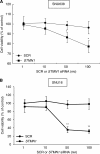Overexpression of stathmin1 in the diffuse type of gastric cancer and its roles in proliferation and migration of gastric cancer cells
- PMID: 20087351
- PMCID: PMC2837578
- DOI: 10.1038/sj.bjc.6605537
Overexpression of stathmin1 in the diffuse type of gastric cancer and its roles in proliferation and migration of gastric cancer cells
Abstract
Background: Stathmin1 is a microtubule-regulating protein that has an important role in the assembly and disassembly of the mitotic spindle. The roles of stathmin1 in carcinogenesis of various cancers, including prostate and breast cancer, have been explored. However, its expression and roles in gastric cancer have not yet been described.
Methods: Stathmin1 expression in paraffin-embedded tissue sections from 226 patients was analysed by immunohistochemistry. Roles of stathmin1 were studied using a specific small interfering RNA (siRNA).
Results: The expression of stathmin1 was positively correlated with lymph node metastasis, TNM stages and vascular invasion, and negatively with recurrence-free survival, in the diffuse type of gastric cancer. The median recurrence-free survival in patients with a negative and positive expression of stathmin1 was 17.0 and 7.0 months, respectively (P=0.009). When the expression of stathmin1 was knocked down using siRNA, the proliferation, migration and invasion of poorly differentiated gastric cancer cells in vitro were significantly inhibited. Moreover, stathmin1 siRNA transfection significantly slowed the growth of xenografts in nude mice.
Conclusion: These results suggest that stathmin1 can be a good prognostic factor for recurrence-free survival rate and is a therapeutic target in diffuse-type gastric cancer.
Figures







Similar articles
-
Lentiviral-mediated RNA interference targeting stathmin1 gene in human gastric cancer cells inhibits proliferation in vitro and tumor growth in vivo.J Transl Med. 2013 Sep 16;11:212. doi: 10.1186/1479-5876-11-212. J Transl Med. 2013. PMID: 24040910 Free PMC article.
-
Stathmin1 plays oncogenic role and is a target of microRNA-223 in gastric cancer.PLoS One. 2012;7(3):e33919. doi: 10.1371/journal.pone.0033919. Epub 2012 Mar 28. PLoS One. 2012. PMID: 22470493 Free PMC article.
-
Hedgehog signaling regulates proliferation of prostate cancer cells via stathmin1.Clin Exp Med. 2010 Mar;10(1):51-7. doi: 10.1007/s10238-009-0068-7. Epub 2009 Sep 25. Clin Exp Med. 2010. PMID: 19779961
-
Phosphorylation at Ser10 triggered p27 degradation and promoted gallbladder carcinoma cell migration and invasion by regulating stathmin1 under glucose deficiency.Cell Signal. 2021 Apr;80:109923. doi: 10.1016/j.cellsig.2021.109923. Epub 2021 Jan 12. Cell Signal. 2021. PMID: 33444777
-
A review on the role of tau and stathmin in gastric cancer metastasis.Eur J Pharmacol. 2021 Oct 5;908:174312. doi: 10.1016/j.ejphar.2021.174312. Epub 2021 Jul 8. Eur J Pharmacol. 2021. PMID: 34245746 Review.
Cited by
-
Combined Proteomics and Transcriptomics Identifies Carboxypeptidase B1 and Nuclear Factor κB (NF-κB) Associated Proteins as Putative Biomarkers of Metastasis in Low Grade Breast Cancer.Mol Cell Proteomics. 2015 Jul;14(7):1814-30. doi: 10.1074/mcp.M114.041335. Epub 2015 Apr 22. Mol Cell Proteomics. 2015. PMID: 25903579 Free PMC article.
-
The prognostic value and therapeutic target role of stathmin-1 in urinary bladder cancer.Br J Cancer. 2014 Sep 9;111(6):1180-7. doi: 10.1038/bjc.2014.427. Epub 2014 Jul 29. Br J Cancer. 2014. PMID: 25072257 Free PMC article.
-
Tumor profiling of co-regulated receptor tyrosine kinase and chemoresistant genes reveal different targeting options for lung and gastroesophageal cancers.Am J Transl Res. 2016 Dec 15;8(12):5729-5740. eCollection 2016. Am J Transl Res. 2016. PMID: 28078044 Free PMC article.
-
WTAP regulates migration and invasion of cholangiocarcinoma cells.J Gastroenterol. 2013 Nov;48(11):1271-82. doi: 10.1007/s00535-013-0748-7. Epub 2013 Jan 25. J Gastroenterol. 2013. PMID: 23354623
-
Clinical significance of Stathmin1 expression and epithelial-mesenchymal transition in curatively resected gastric cancer.Mol Clin Oncol. 2019 Feb;10(2):214-222. doi: 10.3892/mco.2018.1774. Epub 2018 Nov 26. Mol Clin Oncol. 2019. PMID: 30680197 Free PMC article.
References
-
- Belmont LD, Mitchison TJ (1996) Identification of a protein that interacts with tubulin dimers and increases the catastrophe rate of microtubules. Cell 84: 623–631 - PubMed
-
- Chen G, Wang H, Gharib TG, Huang CC, Thomas DG, Shedden KA, Kuick R, Taylor JM, Kardia SL, Misek DE, Giordano TJ, Iannettoni MD, Orringer MB, Hanash SM, Beer DG (2003) Overexpression of oncoprotein 18 correlates with poor differentiation in lung adenocarcinomas. Mol Cell Proteomics 2: 107–116 - PubMed
-
- Friedrich B, Gronberg H, Landstrom M, Gullberg M, Bergh A (1995) Differentiation-stage specific expression of oncoprotein 18 in human and rat prostatic adenocarcinoma. Prostate 27: 102–109 - PubMed
-
- Gavet O, Ozon S, Manceau V, Lawler S, Curmi P, Sobel A (1998) The stathmin phosphoprotein family: intracellular localization and effects on the microtubule network. J Cell Sci 111(Part 22): 3333–3346 - PubMed
Publication types
MeSH terms
Substances
LinkOut - more resources
Full Text Sources
Medical
Miscellaneous

